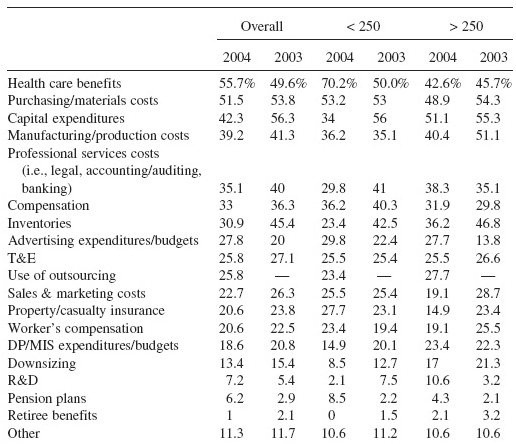Chapter 1
Corporate Cost-Control Strategies
CONTROLLERS’ CORPORATE COST-CUTTING PLANS
Despite the strongest economic environment and profit rebound in the past 20 years for most businesses, companies are still targeting areas in which to further streamline costs. Because of the strength of the expansion, though, controllers at smaller companies have dramatically altered their focus—away from capital spending, where increases are now the norm, and toward areas such as health care costs and purchasing/materials costs, where prices still can be hammered away at (see Exhibit 1.1). An IOMA survey revealed that although hundreds of controllers at larger companies are still focusing mainly on capital spending, other areas are increasingly coming under the spotlight.
Exhibit 1.1 Most Critical Cost-Control Areas, by Number of Employees

Small Firms Identify Health Care Benefits Costs as Main Focus
A whopping 70% of controllers at small firms (less than 250 employees) now target health care costs as their key focus for the next 12 months. To do this, they are increasing cost sharing with employees; increasing co-pays, deductibles, and lifetime limits; changing to prescription programs with two or more tiers; and adding or enhancing voluntary benefits programs.
For the past few years, employers have emphasized cost sharing as the most effective means of controlling benefits costs, along with ...
Get Cost Reduction and Control Best Practices: The Best Ways for a Financial Manager to Save Money, 2nd Edition now with the O’Reilly learning platform.
O’Reilly members experience books, live events, courses curated by job role, and more from O’Reilly and nearly 200 top publishers.

